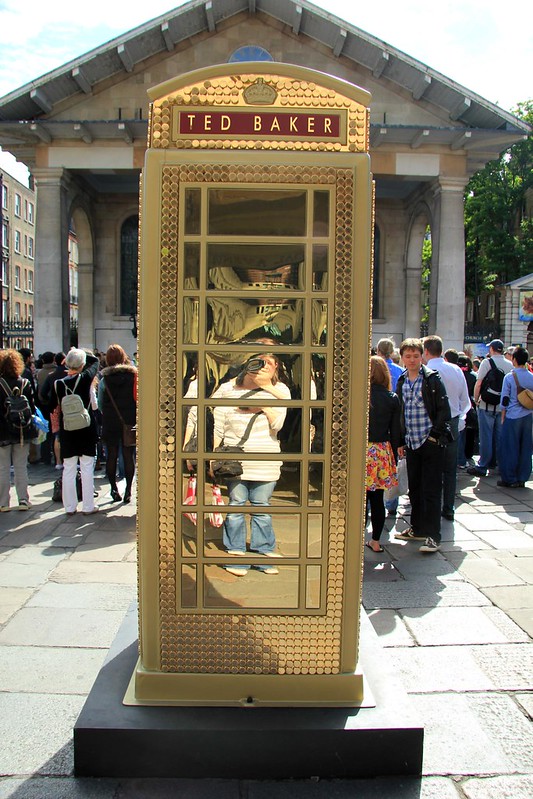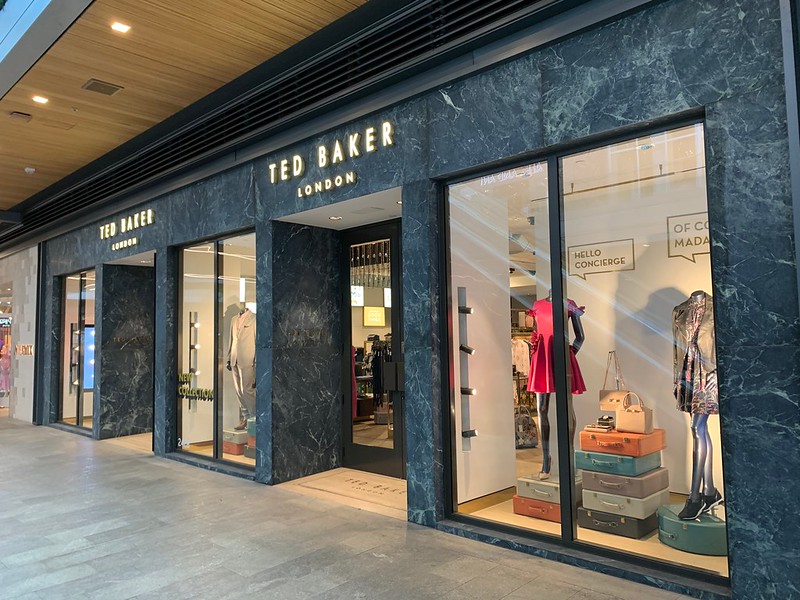Rather than relying on traditional advertising methods, Ted Baker focuses on creating exceptional products, meticulous attention to detail, and a unique sense of humor that resonates with its target audience. This distinctive strategy has fostered a fiercely loyal customer base and generated robust word-of-mouth advocacy.
Ted Baker’s early success was largely driven by innovative marketing tactics that pushed boundaries and emphasized the importance of in-store experiences and personalized customer service. However, over the years, the brand has faced significant challenges, including declining consumer interest, stagnation in its brand image, and a mismatch between product quality (such as the prevalence of synthetic materials) and premium pricing. Furthermore, the brand must navigate intense competition and rapidly shifting fashion trends.
The “No Ordinary Designer Label” Ethos
At its core, Ted Baker’s ethos is built on a simple yet profound principle: that it can be, and should be, better than ordinary. Founded by Ray Kelvin in 1988, the brand has always been guided by an unwavering commitment to quality, attention to detail, and a dash of quirky humor. This unique blend of excellence and individuality is what sets Ted Baker apart from its competitors and defines its enduring brand identity.
One of the key factors that contributed to Ted Baker’s reputation as a “no ordinary designer label” was its pioneering approach to customer service. The brand famously offered a complimentary laundry service for every shirt purchased in its stores, setting a new standard for exceptional customer experiences. This innovative service not only delighted customers but also served as a powerful demonstration of the brand’s commitment to delivering an experience that went far beyond mere transactions.

As Ted Baker expanded its product lines and global reach, this core concept was distilled and reinterpreted to become an overarching brand personality and marketing philosophy. The “no ordinary” ethos was no longer defined by a specific service but had evolved into a guiding principle for the entire brand, influencing everything from product design to store experiences and advertising campaigns.
Ted Baker has always positioned itself as a premium fashion brand, dedicated to creating high-quality, stylish clothing and accessories for a discerning clientele. Its primary target demographic is affluent consumers aged 25-45, who value style, sophistication, and individuality. These individuals are often professionals and executives with higher disposable incomes, willing to invest in premium products that reflect their personal taste.
To further reinforce its market positioning, Ted Baker has diversified its offerings to create a comprehensive lifestyle brand experience. The company now encompasses a wide range of collections, including accessories, footwear, fragrances, homeware, and more. This strategic move allows customers to immerse themselves fully in the Ted Baker world, blurring the lines between fashion and lifestyle.
Core Marketing Philosophy: Eschewing Traditional Advertising
Ted Baker’s marketing strategy has been praised as “genius” due to its bold decision to abandon traditional advertising methods. Instead, the brand relied on word-of-mouth referrals and innovative, often unconventional marketing tactics. This approach was born out of necessity in its early days, when funds were limited and conventional advertising was not an option. By opting out of traditional channels, Ted Baker was able to focus on creating a unique and immersive experience for customers.
One of the key elements of this strategy was the brand’s use of surprise and delight tactics, such as giving away unusual gifts during holidays like Christmas and Easter. These promotions were meticulously designed to support collections in a way that was both consistent and fun, reinforcing Ted Baker’s quirky personality. This approach not only helped the brand stand out from the crowd but also cultivated a unique brand identity characterized by “quirky yet sophisticated designs” and a “distinctly British sense of humor”.
The brand’s unconventional practices, such as banning the word “sale” and using internal language like “Ted’s Threads” and “Ted To Toe”, further reinforced its playful and exclusive image. By embracing an idiosyncratic approach to marketing, Ted Baker was able to create a culture of innovation within its team, where creativity and out-of-the-box thinking were encouraged.
The decision not to use traditional advertising channels forced the brand to find alternative methods for achieving visibility, attracting customers, and driving sales. This strategic constraint ultimately led to a deep-seated culture of creative problem-solving within the brand’s marketing efforts. The early laundry service and subsequent guerrilla tactics are direct manifestations of this approach, which continued with later digital innovations like shoppable videos and interactive experiences.

At its core, Ted Baker’s primary marketing model relies on word-of-mouth referrals and customer advocacy. To drive recommendations, customers must experience exceptional satisfaction from high-quality products and a superior overall customer experience. The brand emphasizes the importance of attention to detail, quality craftsmanship, and immersive environments in creating this experience. By focusing on product excellence and delivering an exceptional customer journey, Ted Baker is able to justify premium pricing and foster organic advocacy, creating a powerful marketing loop that minimizes the need for traditional advertising spend.
Key Marketing Campaigns & Initiatives: Examples and Impact
| Campaign/Initiative | Year/Period | Type | Key Elements/Description | Reported Impact/Results |
| Complimentary Laundry Service | Early years (post-1988) | Experiential/Service | Offering free laundry service for every shirt purchased in early stores. | Earned “No Ordinary Designer Label” title; fostered early customer loyalty and word-of-mouth. |
| Quirky Giveaways | Ongoing (e.g., Christmas, Easter, World Cup 2006) | Guerrilla/Promotional | Distributed Paxo turkey stuffing, chocolate bunny hotpot, World Cup football cards. | Supported collections uniquely, reinforced quirky brand personality, generated buzz |
| Virtual Catwalks | Recent | User-Generated Content (UGC) | Customers showcased their looks on social media; leveraged social media trends. | Turned customers into brand ambassadors, harnessed social media power. |
| Shoppable Video (Guy Ritchie) | 2016 | Digital Video | Mini-film allows viewers to click and save featured items. | Innovative use of video, drove engagement. |
| “Keeping Up with the Bakers” | Spring 2017 | 360-degree Shoppable Film/Episodic Social Media | Immersive film teased on Instagram Stories. Users explored virtual neighborhood, purchased items directly. | Trailer watched 1.9M times, 26,000 in-store window engagements; increased engagement and sales. |
| “Agents of T.E.D.” | Undisclosed (post-2017) | Mobile Voice Search/Shoppable Video | Used window vinyls with coded phrases for mobile voice search to win prizes; shoppable TrueView videos on YouTube. | Main film had 4M views, 60% lift in ad recall, 69% increase in UK consumer searches for “Ted Baker” at peak. |
| Referral Marketing (Mention Me) | From 2018 | Loyalty/Advocacy | Partnership to capture word-of-mouth; A/B testing for optimized incentives (£25 discount preferred). | Referred customers spend 34% more per order, place 7% more orders, 16% higher purchase rate during peak months; increased NPS and CLV. |
| “We’ve Got You.” Underwear Campaign | Nov 2023 | Inclusivity/Partnership | Featured diverse cast of men, products made with Better Cotton, partnership with HUMAN mental health charity. | Promoted inclusivity, diversity, and empowerment; demonstrated commitment to social responsibility. |
Digital Transformation and E-commerce Strategy
Ted Baker has demonstrated a strong commitment to digital channels, allocating 20% of its marketing budget to online initiatives. E-commerce has become a vital revenue stream for the brand, accounting for approximately 40% of sales. In the fiscal year ending January 2021, e-commerce sales contributed £199.2 million and experienced a significant surge in Q4 2022, with digital sales making up 44.3% of retail sales in 2022.
The brand has successfully leveraged social media platforms to engage with its customer base, aiming to build a loyal following and create a sense of community around its brand. A notable viral campaign saw Ted Baker orchestrate virtual catwalks where customers showcased their best looks on social media, effectively harnessing the power of social media trends and turning customers into brand ambassadors. The brand has also strategically partnered with influencers to enhance its online presence and connect with younger, trendier consumers.
Ted Baker has placed a significant focus on video content, recognizing that video will become an increasingly important channel for internet traffic. In 2016, the brand released a pioneering shoppable video directed by Guy Ritchie, allowing viewers to click and save featured items. The “Keeping Up with the Bakers” campaign (Spring 2017) was another innovative effort, using 360-degree shoppable film to allow users to explore a virtual neighborhood and directly purchase items.
The brand’s early marketing efforts were defined by quirky physical tactics, such as giveaways and stunts, which established a brand expectation of novelty and surprise. However, as the brand recognized the rise of e-commerce and digital platforms, it did not abandon its unconventional approach. Instead, Ted Baker skillfully translated the essence of “out of the ordinary” into the digital realm, developing sophisticated campaigns that leveraged social media, shoppable videos, 360-degree films, and interactive window displays.
Ted Baker’s strategic agility and consistency in maintaining its core brand identity have allowed it to adapt to changing media consumption habits. The brand has successfully integrated its online and offline channels to provide a seamless shopping experience for customers, emphasizing a cohesive omnichannel strategy that allows customers to interact with the brand across multiple touchpoints.
Customer Experience and Loyalty Initiatives
Ted Baker’s customer relationships are built on a foundation of exceptional service and personalized engagement. The brand strives to transcend mere transactions by delivering high-level customer service, gifting options, and a touch of British charm in communications. This commitment is evident in their focus on direct, efficient online shopping options, and personalized styling services.
The brand’s physical stores are designed as immersive environments, fostering a deeper connection with customers and promoting repeat visits and long-term loyalty. Examples of this can be seen in the brand’s “Grooming Rooms,” which offer a traditional Turkish barber experience, or their meticulously crafted in-store experiences that resonate with the brand’s distinctive character.
Ted Baker has successfully leveraged customer loyalty programs to drive retention rates and enhance customer satisfaction. Their efforts have yielded impressive results, including a 25% increase in average customer retention rate. The brand’s commitment to above-and-beyond service, personalized engagements, and immersive environments has created a powerful self-sustaining marketing loop.
One key component of this approach is Ted Baker’s referral program, which was launched in partnership with Mention Me in 2018. Through rigorous A/B testing, the brand discovered that customers were more motivated to “give” an offer to friends than to “get” a discount for themselves, and that a £25 discount was preferred over a 10% discount. This data-backed approach has yielded impressive outcomes, including referred customers spending 34% more per order, placing 7% more orders, and having a 16% higher purchase rate during peak months.
The success of Ted Baker’s customer experience initiatives is directly tied to their commitment to delivering a holistic, high-quality experience that encompasses everything from personalized service to unique in-store environments. This approach has created a powerful marketing loop where the superior customer experience itself serves as a primary and highly effective marketing channel, aligning perfectly with their “no traditional advertising” philosophy.
Challenges and Strategic Evolution
In recent years, Ted Baker has faced significant challenges that have impacted its brand perception. A notable decline in consumer interest has been evident, with some markets perceiving the brand as “stagnant” and “out of touch” with evolving trends. One critical issue contributing to this perception is the brand’s practice of charging premium prices for products made from cheap polyester materials.
A recent analysis of Ted Baker’s product offerings revealed that a significant proportion (8 out of 11) of its dresses on the website were composed of high-polyester content, priced between $300-500. This has led to a perception of the brand as “Luxe Basic” or even “tacky” in certain markets, particularly in the UK.
YouGov data corroborates these findings, highlighting a disconnect between Ted Baker’s brand image and its actual product offerings. While the brand is generally perceived as more well-liked than average (Impression score 15.4 vs. 10.8) and of greater quality (27.3 vs. 12.0), it underperforms on key metrics such as Value for Money (-5.8 vs. 3.2 average) and Customer Satisfaction (8.8 vs. 9.9 average).

This inconsistency between Ted Baker’s foundational promise of quality craftsmanship and attention to detail, and the actual product offerings, has created a critical disconnect. When the product itself fails to justify its premium price point, it erodes the effectiveness of all other marketing efforts, including those reliant on organic advocacy.
As a result, Ted Baker’s brand image has become stagnant, struggling to keep pace with evolving trends. This decline in consumer interest and perception is having a significant impact on the brand’s overall success, highlighting the need for a strategic refocus on quality, craftsmanship, and attention to detail.
The fashion industry is highly competitive, with numerous established brands vying for market share. Ted Baker has faced significant challenges in this landscape, particularly from higher-end, high-street fashion brands such as Reiss, Whistles, Mango, and Massimo Dutti. These brands have successfully captured market share by offering more laid-back, athleisure-inspired ranges that appeal to modern consumers.
The COVID-19 pandemic accelerated these shifts in consumer preferences, leading to a pronounced trend towards casual wear and relaxed styles. This presented a significant challenge for Ted Baker, whose traditional focus on occasion wear and formalwear became less relevant. The brand was criticized for its failure to adapt to changing consumer tastes and preferences.
Broader economic conditions, including inflationary pressures and the cost-of-living squeeze, further impacted consumer spending on luxury fashion, posing a particular challenge for mid-market retailers like Ted Baker.
The departure of founder Ray Kelvin had a significant impact on the brand, exacerbated by allegations of misconduct that contributed to instability and poor media profile. This event directly affected brand trust and consumer perception, regardless of marketing efforts.
In response to these challenges, Ted Baker initiated a global brand refresh focused on casualizing its product offer and updating its aesthetics to align with a new way of living. The strategic goal is to offer joyful, modern pieces that cater to contemporary lifestyles and values. A key component of this initiative is a new narrative: “family can be chosen,” which emphasizes non-traditional families, community, and heritage.
This brand refresh aims to re-establish Ted Baker’s identity in modern Britain and cultivate a strong sense of community among consumers. To achieve this, the brand is introducing new strategies, including developing a mobile application with AR features and immersive digital experiences.
Ted Baker’s past failure to adapt to changing consumer preferences has led to a stagnant brand image, characterized as “old,” “uninspired,” and “out of touch.” The global brand refresh directly addresses this by offering a casualized product range and updating product aesthetics to align with modern lifestyles. By embracing contemporary values and lifestyles, Ted Baker aims to regain market relevance, capture a wider demographic, and re-establish a clear, modern identity.
Post-Acquisition Strategy and Future Outlook
Authentic Brands Group (ABG) completed its acquisition of Ted Baker for £211 million in October 2022, marking a significant shift in the brand’s business model. ABG operates as a global brand development platform, leveraging extensive licensing agreements to drive growth and revenue.
Prior to the acquisition, Ted Baker operated through a diversified business model encompassing retail, wholesale, and licensing. However, following the acquisition, ABG began signing new partnerships with key players, including United Legwear & Apparel Co. (ULAC) for e-commerce and men’s sportswear, and Peerless Clothing for tailored clothing.
This strategic shift marks a significant departure from Ted Baker’s traditional vertically integrated retail model, which came with high operational overheads. By partnering with ABG, Ted Baker can now focus on brand management, leveraging the conglomerate’s expertise in connecting iconic brands with best-in-class partners to optimize long-term value.
The new licensing partners will play a crucial role in extending Ted Baker’s presence across key markets, including the US and Canada. ULAC will manage wholesale, concession shops, and e-commerce operations for Ted Baker in these regions, while Peerless Clothing will handle tailored clothing and other specific product categories.
ABG has announced plans to revamp Ted Baker’s online shopping experience, with an anticipated launch in autumn 2023. The new platform aims to provide a seamless and engaging experience that exceeds customer expectations, further cementing Ted Baker’s position as a leader in the fashion industry.
Ted Baker’s commitment to sustainability is also being highlighted through its marketing efforts. The brand has pledged to become carbon neutral by 2030, integrating environmental considerations into every aspect of its operations. This commitment includes ethical sourcing and waste reduction in its supply chain, resonating with environmentally conscious consumers who are increasingly looking for brands that share their values.
The brand’s recent campaigns, such as “We’ve Got You.” underwear, demonstrate a broader commitment to social responsibility, highlighting inclusivity, diversity, and partnerships with social causes. This proactive approach is essential in differentiating Ted Baker from its competitors and appealing to the growing segment of ethically conscious consumers.
Internationally, Ted Baker has a strong presence across Europe, the US, Canada, Australia, Asia, South Africa, and the Middle East. With ABG’s extensive global footprint spanning 150 countries with over 13,000 freestanding stores and 400,000 points of sale, the brand is well-positioned to accelerate its international growth and tap into new customer bases worldwide.
Ted Baker’s Enduring Marketing Strengths
- Distinctive Brand Identity: Ted Baker’s unique blend of exceptional product quality, meticulous attention to detail, and British sense of humor has established a strong brand identity.
- Innovative Marketing Tactics: The brand’s early success was driven by creative marketing campaigns, including word-of-mouth initiatives, guerrilla marketing, and immersive retail experiences.
- Customer-Centric Approach: Ted Baker has maintained a loyal customer base through effective loyalty programs and successful referral marketing efforts.
- Digital Adoption: The brand demonstrated foresight in its digital adoption, investing heavily in e-commerce and pioneering shoppable video content and user-generated content campaigns.
Overall, Ted Baker’s marketing strengths are rooted in its unique brand identity and innovative marketing tactics. However, the brand faces challenges in regaining relevance, adapting to changing consumer preferences, and maintaining a strong value proposition.

